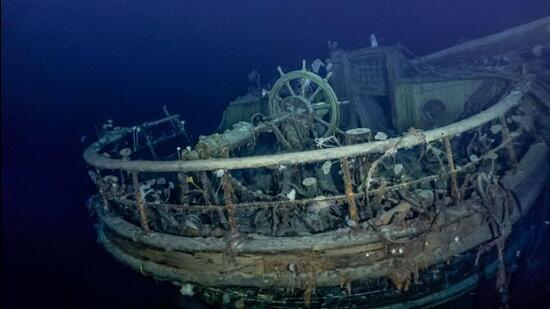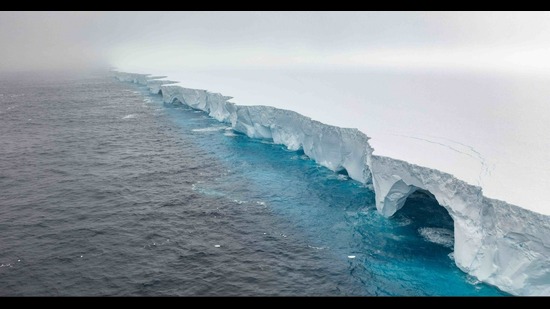Cracks in the ice: A continental shift in Antarctica
The continent is recording new lows in sea ice and new highs in temperature. Penguins are seeing record die-offs. What else is the ice telling us? Take a look.
Antarctica is Earth’s coldest region, oldest ecosystem, and largest and driest desert. The lowest temperature recorded here has been -98 degrees Celsius (on the East Antarctic Plateau).

Even as the Arctic ice cap shrank, amid global warming, Antarctica remained stable. Since the late 1970s, when it first began to be mapped from space, its ice shelves and average temperatures remained within normal range, with sea ice peaking, in fact, in 2014.
It has been a rapid slide since. Sea-ice levels (the point to which ice extends into the sea) have reached four successive lows, in the seven years since 2016.
In February 2023, the sea-ice minimum was 20% lower than the average over the past 40 years. In September, the maximum extent also registered a record low, at 1.75 million sq km below average.
“Microplastics are appearing in the food chain in Antarctica. Commercial fishing is increasing. Tourism has reached an all-time high of over 100,000 visitors last year,” says Steven Emslie, an ornithologist and researcher at the University of North Carolina who studies penguin colonies in Antarctica.
Avian flu is reaching penguins and other seabird colonies, he adds. “These could be devastating, especially to emperor penguins which are already in decline.”
Shelf lives
Humans began exploring Antarctica about 200 years ago. There are still disputes over who first landed on the continent, but landings began in the early 1820s.

Nearly a century later, Anglo-Irish explorer Ernest Shackleton famously set out to be the first to trek across Antarctica, via the South Pole. He only made it to the edges of the continent, in a journey that saw his massive ship, the Endurance (above, as seen in 2022), crushed by pack ice on approach. It sank in the Weddell Sea, in 1915, leaving him and his crew camped on ice floes for over five months. Some of the crew made it back to South America in lifeboats, and returned to rescue the others. Surprisingly, there were no fatalities.
A key hurdle to making it to Antarctica was the stormy Drake Passage (named after the 16th-century English explorer Francis Drake). This is the narrow, windswept channel of the Southern Ocean that lies between the southernmost tip of South America and the northernmost point of Antarctica. Today, Drake Passage is also called Iceberg Alley, for the many icebergs that drift north, along it, to melt into the ocean.
A heat wave
A number of meteorological factors are warming this continent of ice. The polar vortex, a band of strong westerly winds in the southern hemisphere that helps keep the continent cool, has weakened, allowing tropical warm air to cross the Southern Ocean to reach the ice sheet. Atmospheric rivers – belts of moisture that can be hundreds of kilometres wide – are adding to the shifts. These and other such meteorological factors come, of course, in addition to the global warming caused by industrial-era emissions.
The results have been dramatic.
On February 6, 2020, continental Antarctica had its hottest day on record, with temperatures rising to 18.3 degrees Celsius.

On February 9, 2020, Seymour Island in the Antarctic Peninsula hit 20.75 degrees Celsius, the first time in recorded history that temperatures anywhere in Antarctica had breached the 20-degree mark.
Then came the heat wave of March 2022, which raised average temperatures to more than 30 degrees Celsius above normal. Temperatures reached -9.4 degrees Celsius on the Antarctic Plateau in East Antarctica, at a time of year when they usually stand at -40 to -50 degrees Celsius.
This heatwave, climatologists said, was caused by atmospheric rivers and the moisture they carried from the tropics and subtropics to the polar region.
“The polar region is protected from these by the polar vortex,” says Thamban Meloth, director of India’s National Centre for Polar and Ocean Research. “Partly because of global warming and the ozone hole, this vortex is meandering or weakening in places. Under such conditions, atmospheric rivers can invade and cause sudden changes to the weather.”
Iceberg, right ahead!
Amid the warming and consequent melting, the world’s largest iceberg is on the move. A23a (below) is moving north, along Iceberg Alley. Seafarers have been advised to keep an eye out for the giant, whose surface measures 3,800 sq km, almost three times the size of Delhi.

Icebergs calving off ice shelves is not new, but the rate of such calving has sped up. Studies by NASA’s Jet Propulsion Laboratory published in 2022 in the journals Nature and Earth System Science Data reported that, over 25 years, Antarctica’s floating ice shelves have been shedding icebergs faster than the ice can be replaced, owing to warming ocean waters.
It’s a continent of ice and it is crumbling at its edges.
“Ice shelves are floating tongues that extend from glaciers and ice sheets, from which icebergs are formed. They play a critical role in containing large ice sheets on land. They act like the cork in a bottle of sparkling wine. When the cork is popped, the wine rushes out. Something similar will happen with the ice sheets, as the ice shelves break down, which will increase the rate of global sea-level rise,” Meloth says.
Emperors in decline
Can life cling on, as the ice melts?
Sea ice disappearing too early wiped out four of five emperor penguin colonies being observed in the Bellingshausen Sea, in December 2022. About 9,000 chicks died in all, in the first such regional mass die-off on record.
As the slabs on which they were born melted away beneath them, the fledglings — their coats still not waterproof — likely drowned or froze to death. Their coats would have been waterproof by January, which is when sea ice usually begins to melt.
“Although there have been isolated cases of colonies being affected by early sea ice loss, this is the first recorded case of a regional failure – where the majority of colonies in a region have all failed in one season,” says Peter Fretwell, a researcher with the British Antarctic Survey. “If these events continue, the population will decline.”
According to Fretwell, almost a third of emperor penguin colonies across Antarctica were affected by early sea ice loss in 2022. They are currently assessing imagery from 2023, he says, “but early signs are that it has been another bad year”.
At the pole
India currently has two bases in Antarctica. Maitri, set up in 1989, and Bharati, built using 134 shipping containers, in 2012. These stations serve as centres to study meteorology, geology, flora and fauna, and polar processes and phenomena.

“We have identified several new species of microbial organisms that thrive in extremely low temperatures and we’re studying them for their properties and potential applications,” says Meloth; the National Centre for Polar and Ocean Research (NCPOR) that he heads maintains the two stations.
In 2017, Indian polar biologists also found a new species of moss at Larsemann Hills near the Bharati station, which they named Bryum bharatiensis. This station also doubles as a remote satellite receiver for the Indian Space Research Organisation.
A new station, to replace the aging Maitri, will likely be completed in 2030. Scan the QR code alongside for more on the latest research stations here, including India’s current and proposed ones.
Core truths
Ice cores extracted from Antarctica are revealing vital details about the composition of air and water in prehistoric times. But what they reveal about our recent past is arguably more dramatic. Because they act as evidence of the impact of human activity, in ways that also reinforce a heartening truth: That damage can be undone, and that actions can make a difference. Take a look.
1750: Carbon-dioxide levels begin to rise, driven by global changes in land use, linked to new patterns of agriculture and livestock farming
1765: Carbon-dioxide levels reach 280 parts per million (ppm), near the pre-existing peak in the 800,000-year history represented by the ice cores
1870: Methane levels exceed the previous peak
1889: Lead pollution linked to Australian lead mining and industrial activity is detected
1900: An increase in sulphates is detected, and linked to the spread of coal-fired power plants globally
1915: Carbon dioxide concentration reaches 300 ppm, surpassing the pre-existing high
1950: An increase in nitrates is detected, linked to the spread of cars and oil-fired power plants
1954: Radioactive by-products are detected, attributed to nuclear tests
1950-80: Lead levels rise, attributed to additives in automotive fuel
1964-65: Atmospheric radioactivity signatures peak. They fall sharply in the years that follow, in the wake of the 1963 Nuclear Test Ban Treaty, which bans all above ground testing
1970: Methane concentrations reach double the pre-industrial peak represented in the ice cores
1975: Traces of DDT, used widely as an insecticide at this time, appear
1980: Lead levels begin to fall, reflecting the switch to unleaded petrol
2016: Carbon dioxide concentration reaches 400 ppm, nearly 1.5 times greater than the pre-industrial levels in the core
(Sources: British Antarctic Survey; NASA National Snow and Ice Data Center; Keeling CK et al, 1976; Etheridge DM et al, 1992; Machida T et al 1995; McConnell Joe, 2024)
What will future ice cores reveal? What is the story we want them to tell? Those are the questions we are answering, with every purchase, decision and vote we make today.








